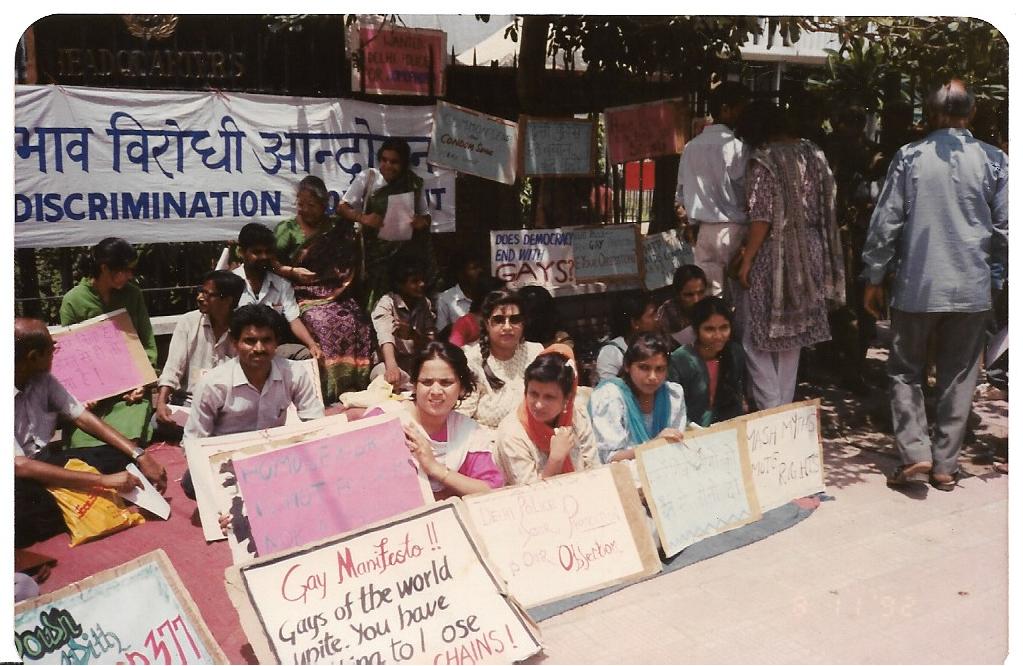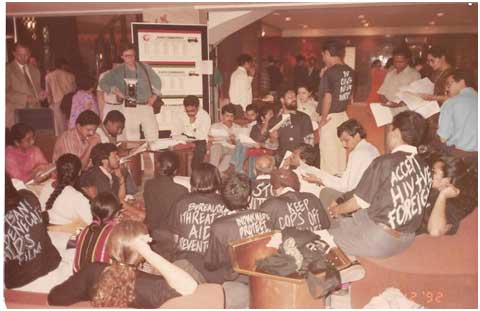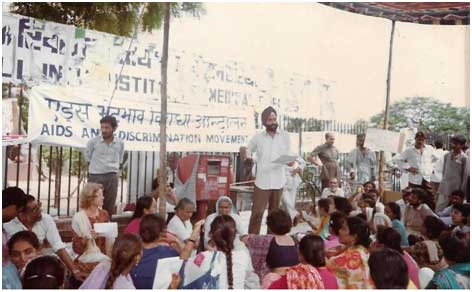More often than not, it is a sustained and committed effort against discrimination that brings about significant changes in policies, in legislation and most importantly, in popular perception. AIDS Bhedbhav Virodhi Andolan (ABVA) began important conversations in the 1990s, with its effort to secure rights for those found to be HIV positive, and its attempts to dispel stigmas about vulnerable groups like sex workers, and the queer community. ABVA started as a group of volunteers from various backgrounds, around 1988, who worked together for improving the living conditions of sex workers in Delhi’s red-light area, G.B. Road. Their focus soon broadened to advocating for rights for those who were HIV positive, especially after a group of women from G.B Road were forcefully tested by doctors from AIIMS, with the help of the police.

The Stigma Around AIDS And Medical Malpractices
Even as HIV was diagnosed in India amongst six sex workers in Chennai in 1986, almost 27 years after the first case was reported in Congo in 1959, there was little research about what being tested HIV positive meant. The virus was found to be fatalistic, which created rumours, not only about how the disease spread, but also about the character of a person who tested positive. In a citizen’s report published in 1990 titled “Women & AIDS”, the ABVA aimed to discuss the myths and facts about what AIDS and HIV were and how they spread. Through first person accounts and analysing laws like Immoral Traffic(Preventions) Act, 1986, the ABVA highlighted how vulnerable groups like sex workers faced harassment, both from society for being involved in prostitution, and from legislation that were meant to function as safeguards, but only made them more helpless.
Even as HIV was diagnosed in India amongst six sex workers in Chennai in 1986, almost 27 years after the first case was reported in Congo in 1959, there was little research about what being tested HIV positive meant. The virus was found to be fatalistic, which created rumours, not only about how the disease spread, but also about the character of a person who tested positive.
The role of the government, and the police only added to their desperation, making it impossible for sex workers to live with dignity. While the government tried to ‘rehabilitate’ these women in shelter homes, there was little done to further their integration into society. In fact, the state of these shelter homes were in despicable conditions, there was no scope of any vocational or economic training, and marriage was thought to be the only way through which these women could be rehabilitated.
The ABVA exposed how AIDS was used to “damn women”, especially sex workers, deeming them to be promiscuous. AIDS was also seen as something prevalent in same sex partners, who were thus condemned for having ‘unnatural’ sex. The ABVA included personal accounts of how AIDS patients were denied medical assistance at AIIMS, how campaigns by the Indian Council of Medical Research made unscientific statistical claims like, “Every third house-wife of Bombay would have AIDS by 1995” and how they promoted homosexuality as something unnatural and harmful to health.
Woman & AIDS also shed light on the isolation faced by those who tested HIV positive – many were even jailed instead of receiving medical attention, which thereby conveyed that they were dangerous to society. In fact, the Goa Public Health Act was amended in 1987 so that people who were found to HIV positive were mandatorily isolated from the rest of the population.

The report also highlighted the lapses of the medical community, and their inability and unwillingness to follow WHO guidelines while dealing with HIV positive patients. Further, the ABVA exposed other gross violations of medical ethics – surgeons and nurses threatened to resign when the first case of HIV was diagnosed in Gauhati (now Guwahati) Medical College Hospital; AIIMS doctors refused life-saving treatment to an African envoy with AIDS, who consequently died; blood banks printed posters names, addresses and phone numbers of professional donors “wanted for AIDS”. All of this led to a notorious AIDS Prevention Bill, which would strip the rights and dignity of those tested HIV positive, while giving a clean chit to doctors, pharmaceutical companies etc.
The AIDS Prevention Bill, 1989 And ABVA’s Actions
Perhaps ABVA’s most significant effort was its success in stalling the AIDS Prevention Bill, tabled secretly in the Rajya Sabha, in 1989. It aimed to give medical professionals and government authorities unprecedented power, while violating rights of the citizens. All licenced medical practitioners were mandated to inform the location of an HIV positive person; health authorities could forcibly test those said to be at ‘higher-risk’ of contracting HIV; the health authorities were also given powers to undertake any precautionary measures they felt were necessary to keep the spread of HIV under check.

The Bill also failed to provide any objectives of how HIV positive people would be medically treated, and how they would check the spread of AIDS. At the centre of the Bill was the idea of “high-risk groups”, those who were considered to be more vulnerable to contracting HIV, even though it was medically proven that no social group was more prone to the virus than another.
Perhaps ABVA’s most significant effort was its success in stalling the AIDS Prevention Bill, tabled secretly in the Rajya Sabha, in 1989. It aimed to give medical professionals and government authorities unprecedented power, while violating rights of the citizens.
It became clear that the rights of people would be clearly violated with this Bill. For starters, anybody could be made to undergo HIV testing without their consent. Personal and private information about HIV positive patients could be revealed to the public and to the police authorities as an attempt to contain the spread of HIV. And finally, none of those found to be HIV positive were guaranteed medical treatment, not to mention that the idea of ‘high-risk’ groups could further isolate those who were already mariginalised (like sex workers and queer people).
Also read: Book Review: Forsaken: An AIDS Memoir By Alexandre Bergamini
The ABVA, through numerous petitions to the Parliament, managed to stall the Bill’s passing, and the it was ultimately withdrawn. It also organised various protests against the treatment of HIV positive patients, and aimed to educate factual information about AIDS, its spread and its prevention. In 1994, ABVA also filed a petition in the High Court against Kiran Bedi’s attempt to block the distribution of condoms in Tihar Jail. ABVA even filed a writ petition challenging the constitutionality of Section 377. Even though it did not pursue the petition to its conclusion, the event revealed the prominent opinions against homosexuality, with Bedi famously commenting about how condom distribution in the jail would encourage “homosexual behaviour”.
Less Than Gay – Rights For The LGBTQ+ Community
Another important effort of the ABVA was its attempt to challenge sodomy laws and demand rights for the LGBTQ+ community. In 1991, it published a report, “Less than Gay”, which is hailed as one of the first reports to demand decriminalising of consensual sex amongst same sex partners under Section 377. Not only did they hope to explain what terminologies such as gay, lesbian, transgenders meant, but also attempted to shed light on the connotations these terms carried, and how it affected those who were forced to remain closeted because of popular perceptions.
The ABVA itself aimed to unlearn prominent notions against homosexuality and detailed out experiences of the community from different parts of India. The report had nuanced acknowledgements about how ABVA could find fewer stories about being lesbian in India, and about how different sexualities and sexual unions have been prominent in the myths, histories and religious sects of India. ABVA also challenged popular rumours about homosexuality like, “Homosexuality is caused by traumatic childhood experiences”, “Gay men are effeminate, lesbians are manly”, “Gay men are hijras” by debating how these myths have no base in reality.

Less than Gay is perhaps even more seminal because of its interpretation of existing sodomy laws in India, and how they violated rights of its citizens. The report challenged section 377, the assumption that consent is applied in marriage, laws relating to homosexuality in the Indian Armed Forces, and how a judge’s personal views can irrationally affect judgements. Most interestingly, ABVA also highlighted the role of science and medicine in influencing and perpetuating prejudices about homosexuality, especially in the West.
It deliberates upon how homosexuality began being seen as a mental sickness, how masturbation was perceived as a disease, and how homosexuals were seen as a threat to the order of society. Scientists in India thought of homosexuality as ‘alien’ to Indian culture, and how Directorate General of Health Services (DGHS) that Indians found out about homosexuality only because of AIDS.
It also talks about the excesses committed by the police, and how the LGBTQ community’s attempt to express their sexuality has often resulted in both social and sexual harassment from all parts of the society. The report ends with a charter of 15 demands which deal with guaranteeing rights and protection to gay people and those tested HIV positive. It also advocated for right to privacy to be declared as a fundamental right for all. Finally, it asked for reforms in discriminating legislatures, police structure and recognition of families that do not conform to hetero-normative structures.
Also read: Employees Of Special Schools In Kerala Fight For Better Aids From The Government
Since its inception, AIDS Bhedbhav Virodhi Andolan has been advocating for a sex positive society by challenging laws, questioning administrative practices and confronting social prejudices. 20 years on, Section 377 has been repealed and the right to privacy is now considered a fundamental right under Article 21 of the Indian Constitution.
Even the Human Immunodeficiency Virus and Acquired Immune Deficiency Syndrome (Prevention and Control) Act, 2017 is a positive step towards non-discriminatory and protective legislation for those with HIV – AIDS, in conjunction with India’s international obligations as a signatory to the Declaration of Commitment on Human Immunodeficiency Virus and Acquired Immune Deficiency Syndrome. And while there is an increase in the representation of problems faced by marginalised groups, the fight for a truly sex positive society is still on.
References
- Women & AIDS, 1990
- Less than Gay, 1991
- Kiran Bedi advocates abstinence over homosexuality
- Section 377 Supreme Court judgement
- Right to privacy as a Fundamental Right
- Human Immunodeficiency Virus and Acquired Immune Deficiency Syndrome (Prevention and Control) Act
Featured Image Source: Ritika Banerjee for Feminism in India
About the author(s)
Suyashi Smridhi is an aspiring writer and journalist from Patna. Her work has appeared on platforms like sbcltr.in, Coldnoon- International Journal of Travel Writing and Travelling Cultures amongst others. She is an alumnus of the Summer Institute, University of Iowa, a two-week creative writing cum cultural exchange program between India, Pakistan and the US.





I was pleasantly surprised to come across this article while doing some other research. However, a typographical error has crept in the title of the article; it should read ’32 years on’ instead of “22 Years On, AIDS Bhedbhav Virodhi Andolan: The Struggle Continues”.